Divisions
The squadron was split further into divisions, usually with three divisions in each intake (currently six per year including three in the opposing Cunningham Squadron). These divisions are named Somerset, St Albans, Sutherland, Diamond, Dragon, Defender, Ocean, Illustrious and Dauntless. Ark Royal, the flight division, is also affiliated to the squadron for administrative purposes, although each member remains within the squadron they joined in Phase 1. Wave Ruler, the RFA intake, is also part of the squadron for their time at BRNC.
Squadrons have now been removed, with the college being broken into 6 main divisions (St Vincent, Cunningham, Blake, Drake, Howe and Hawke) for Direct Graduate Entry, Non Graduate Entry, Upper Yardsman and foreign Officer Cadets, with additional divisions for other cadets in the college (e.g. Shackleton for RFA cadets).

Military ranks are a system of hierarchical relationships, within armed forces, police, intelligence agencies or other institutions organized along military lines. The military rank system defines dominance, authority, and responsibility in a military hierarchy. It incorporates the principles of exercising power and authority into the military chain of command—the succession of commanders superior to subordinates through which command is exercised. The military chain of command constructs an important component for organized collective action.

The Royal Military Academy Sandhurst, commonly known simply as Sandhurst, is one of several military academies of the United Kingdom and is the British Army's initial officer training centre. It is located in the town of Sandhurst, Berkshire, though its ceremonial entrance is in Camberley, Surrey, southwest of London. The academy's stated aim is to be "the national centre of excellence for leadership". All British Army officers, including late-entry officers who were previously Warrant Officers, as well as other men and women from overseas, are trained at the academy. Sandhurst is the British Army equivalent of the Britannia Royal Naval College and the Royal Air Force College Cranwell.
A midshipman is an officer of the lowest rank in the Royal Navy, United States Navy, and many Commonwealth navies. Commonwealth countries which use the rank include Canada, Australia, Bangladesh, Namibia, New Zealand, South Africa, India, Pakistan, Singapore, Sri Lanka, and Kenya.
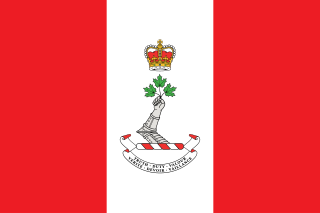
The Royal Military College of Canada, abbreviated in English as RMC and in French as CMR, is a military academy and, since 1959, a degree-granting university of the Canadian Armed Forces. It was established in 1874 and conducted its first classes on June 1, 1876. The Government of Ontario empowered RMC to confer degrees in the Social Sciences and Humanities, Science, and Engineering through The Royal Military College of Canada Degrees Act, 1959. Programs are offered at the undergraduate and graduate levels, both on campus as well as through the college's distance learning programme via the Division of Continuing Studies.
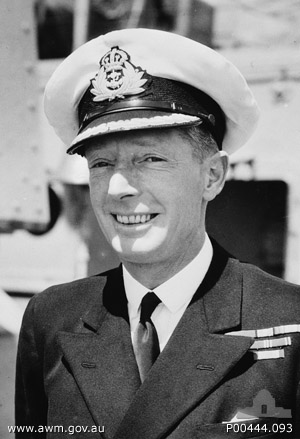
Vice Admiral Sir John Augustine Collins, was a Royal Australian Navy (RAN) officer who served in both World Wars, and who eventually rose to become a vice admiral and Chief of Naval Staff. Collins was one of the first graduates of the Royal Australian Naval College to attain flag rank. During the Second World War, he commanded the cruiser HMAS Sydney in the Mediterranean campaign. He led the Australian Naval Squadron in the Pacific theatre and was wounded in the first recorded kamikaze attack, in 1944.

RFA Fort Rosalie was the lead ship of her class of Royal Fleet Auxiliary fleet replenishment ships. Fort Rosalie was originally named RFA Fort Grange, but was renamed in May 2000 to avoid confusion with the now-decommissioned RFA Fort George. On 31 March 2021, the ship was withdrawn from service.
A cadet is a student or trainee, and is typically used in military settings to denote an individual undergoing training to become commissioned officers. Several civilian organisations, including civil aviation groups, maritime organisations, and police services, also designate their trainees as cadets.
Officer Cadet is a rank held by military cadets during their training to become commissioned officers. In the United Kingdom, the rank is also used by members of University Royal Naval Units, University Officer Training Corps and University Air Squadron; however, these are not trainee officers with many not choosing a career in the armed forces.
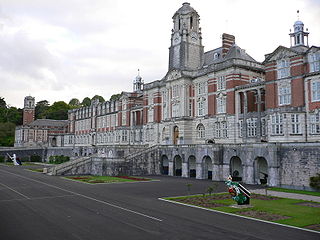
Britannia Royal Naval College (BRNC), commonly known as Dartmouth, is the naval academy of the United Kingdom and the initial officer training establishment of the Royal Navy. It is located on a hill overlooking the port of Dartmouth, Devon, England. Royal Naval officer training has taken place in Dartmouth since 1863. The buildings of the current campus were completed in 1905. Earlier students lived in two wooden hulks moored in the River Dart. Since 1998, BRNC has been the sole centre for Royal Naval officer training.
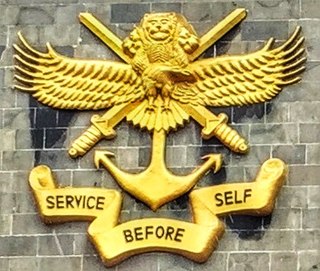
The National Defence Academy (NDA) is the joint defence service training institute of the Indian Armed Forces, where cadets of the Indian Army, Indian Navy, and Indian Air Force train together before they go on to their respective service academy for further pre-commission training. The NDA is located in Khadakwasla, Pune, Maharashtra. It is the first tri-service academy in the world.

Hector Macdonald Laws Waller, was a senior officer in the Royal Australian Navy (RAN). His career spanned almost thirty years, including service in both world wars. At the helm of the flotilla leader HMAS Stuart in the Mediterranean from 1939 to 1941, he won recognition as a skilful ship's captain and flotilla commander. He then transferred to the South West Pacific as captain of the light cruiser HMAS Perth, and went down with his ship during the Battle of Sunda Strait in early 1942.
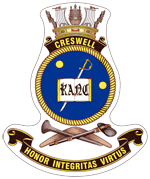
HMAS Creswell, is the training facility of the Royal Australian Navy (RAN) that predominately includes The Royal Australian Naval College (RANC) as well as the School of Survivability and Ship's Safety, the Beecroft Weapons Range, an administrative support department and Training Ship Jervis Bay. It is located between Jervis Bay Village and Greenpatch, on the shores of Jervis Bay in the Jervis Bay Territory. The RANC has been the initial officer training establishment of the Royal Australian Navy since 1915.

The Commander United Kingdom Strike Force is a senior post in the Royal Navy.

The Australian Defence Force Academy (ADFA) is a tri-service military Academy that provides military and academic education for junior officers of the Australian Defence Force in the Royal Australian Navy (RAN), Australian Army and Royal Australian Air Force (RAAF). In 2016 the Academy began accepting civilian students in its undergraduate courses.

The Royal Air Force College (RAFC) is the Royal Air Force military academy which provides initial training to all RAF personnel who are preparing to become commissioned officers. The College also provides initial training to aircrew cadets and is responsible for all RAF recruiting along with officer and aircrew selection. Originally established as a naval aviation training centre during World War I, the College was established as the world's first air academy in 1919. During World War II, the College was closed and its facilities were used as a flying training school. Reopening after the War, the College absorbed the Royal Air Force Technical College in 1966.

The Indian Naval Academy is the defence service training establishment for officer cadre of the Indian Naval Service and the Indian Coast Guard, located in Ezhimala, Kannur district, Kerala. Situated between Ezhimala hill and the Kavvayi backwaters, INA has a 7 kilometre beach front on the Laccadive Sea. It conducts basic training for all officers inducted into the Indian Navy and Indian Coast Guard. It is Asia's largest, and the world's third-largest, naval academy.

The Brazilian Air Force Academy is the Brazilian Air Force's educational institution that provides initial officer training for the main Officer Board of Brazil's Air Force Command. The academy is located east of Pirassununga city, in São Paulo State county, and it is the largest Brazilian Air Base as well as the largest Air Force Academy of Latin America. All three Officer Formation Courses (CFOs) of Academia da Força Aérea are recognized as Superior Degree by Brazil's Ministry of Educations.

An officer is a person who holds a position of authority as a member of an armed force or uniformed service.
In 1989 the Royal Navy was under the direction of the Navy Department in the UK Ministry of Defence. It had two main commands, CINCFLEET and Naval Home Command.

The University Royal Naval Unit East Scotland is one of 17 University Royal Naval Units and a Royal Navy training establishment based in Scotland, accepting roughly 65 Officer Cadets from universities in Edinburgh, Fife and the Tayside region. It is one of the University Service Units and is under the command of Britannia Royal Naval College, Dartmouth. The unit's affiliated P2000 ship is HMS Archer, which is predominantly used for training Officer Cadets.















